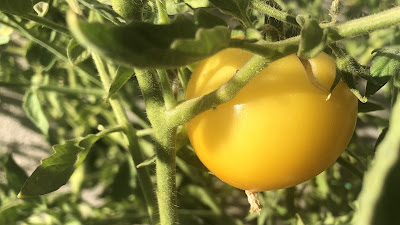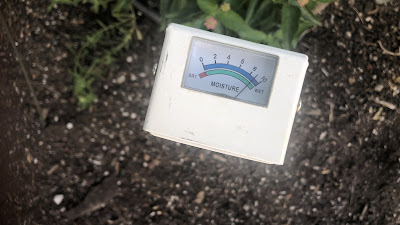
How to help your garden cope with 112 degrees

|
|
Harvesting your ripe or even nearly ripe vegetables
is a good idea ahead of our expected heat wave
this weekend. (Photos: Kathy Morrison) |
We’re having (another) heat wave, and this one may be of record proportions.
According to the National Weather Service, much of Northern California is under an “excessive heat watch,” with some pretty ominous warnings for Labor Day weekend.
“An excessive heat watch is an extended period of dangerously hot conditions with record temperatures up to 115 possible,” says the weather service. “Extreme heat will significantly increase the potential for heat-related illnesses, particularly for those working or participating in outdoor activities over the holiday weekend.”
Those activities, of course, include gardening. Get any chores done early, before 9 a.m. if possible. Wear a hat and sunscreen. Stay hydrated. Retreat to the shade or indoors as quickly as possible.
The hottest days are expected to be Sunday and Monday, but no cooldown is in sight until sometime next week.
The current NWS forecast high for Downtown Sacramento on Sunday and Monday: 112 degrees.
Nights will be warm, too, says the weather service. “There will be limited overnight relief from the heat, with lows in the upper 60s to mid 80s.”
Those 112 marks, if reached, would be records, not only as the hottest Labor Day weekend on record but hottest Sacramento September days ever. Labor Day 2020 (Sept. 6, 2020) tied the current mark – 109 degrees – originally set in September 1955.
If that dire 115 degrees mark comes to pass, history is possible, edging past a nearly century-old milestone. Downtown Sacramento’s all-time record is 114 degrees, set in July 1925. Sacramento Executive Airport recorded 115 degrees – South Sacramento’s hottest day ever – in June 1961.

|
|
Soil moisture is a key preventive measure for plants in
a heat wave. Mulch and/or temporary shade helps, too.
|
Deep-water your garden early in the day or overnight. Wilting in the heat of the afternoon is normal, especially for big-leafed plants such as squash or hydrangeas. But if you see a droopy plant early in the morning, give it a drink.
Otherwise, watch out for sunburn – on you and your vegetables. Provide temporary shade to ripening peppers, tomatoes and eggplant that may be prone to sunburn. Better yet, harvest what you can before this weekend’s heat. Without its fruit, the plant won’t need as much water and can concentrate its energies (and moisture) on survival.
For more on heat stress and plants: http://ipm.ucanr.edu/PMG/GARDEN/ENVIRON/thermal.html .
Comments
0 comments have been posted.Sacramento Digs Gardening to your inbox.
Food in My Back Yard Series
May 6: Maintain soil moisture with mulch for garden success
April 29: What's (already) wrong with my tomato plants?
April 22: Should you stock up on fertilizer? (Yes!)
April 15: Grow culinary herbs in containers
April 8: When to plant summer vegetables
April 1: Don't be fooled by these garden myths
March 25: Fertilizer tips: How to 'feed' your vegetables for healthy growth
March 18: Time to give vegetable seedlings some more space
March 11: Ways to win the fight against weeds
March 4: Potatoes from the garden
Feb. 25: Plant a fruit tree now -- for later
Feb. 18: How to squeeze more food into less space
Feb. 11: When to plant? Consider staggering your transplants
Feb. 4: Starting in seed starting
Sites We Like
Garden Checklist for week of May 4
Enjoy this spring weather – and get gardening!
* Plant, plant, plant! It’s prime planting season in the Sacramento area. Time to set out those tomato transplants along with peppers and eggplants. Pinch off any flowers on new transplants to make them concentrate on establishing roots instead of setting premature fruit.
* Direct-seed melons, cucumbers, summer squash, corn, radishes, pumpkins and annual herbs such as basil.
* Harvest cabbage, lettuce, peas and green onions.
* In the flower garden, direct-seed sunflowers, cosmos, salvia, zinnias, marigolds, celosia and asters. (You also can transplant seedlings for many of the same flowers.)
* Plant dahlia tubers. Other perennials to set out include verbena, coreopsis, coneflower and astilbe.
* Transplant petunias, marigolds and perennial flowers such as astilbe, columbine, coneflowers, coreopsis, dahlias, rudbeckia and verbena.
* Keep an eye out for slugs, snails, earwigs and aphids that want to dine on tender new growth.
* Feed summer bloomers with a balanced fertilizer.
* For continued bloom, cut off spent flowers on roses as well as other flowering plants.
* Add mulch to the garden to maintain moisture. Mulch also cuts down on weeds. But don’t let it mound around the stems or trunks of trees or shrubs. Leave about a 6-inch to 1-foot circle to avoid crown rot or other problems.